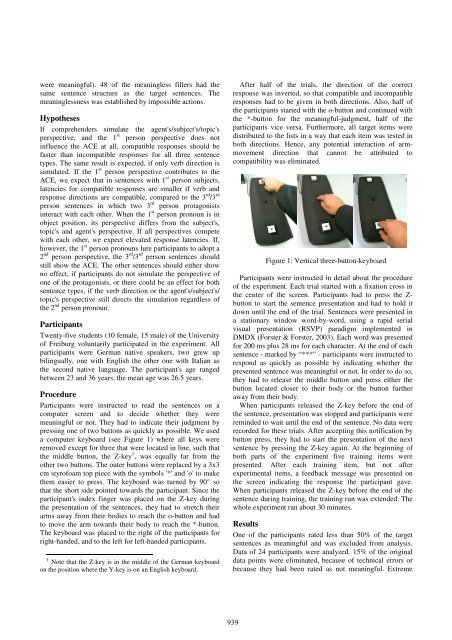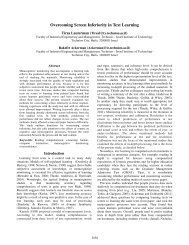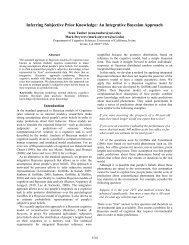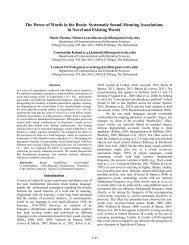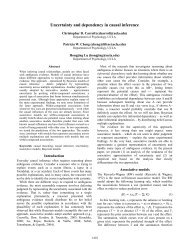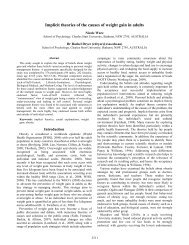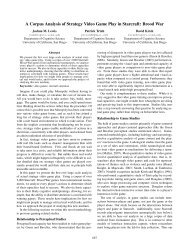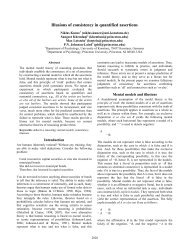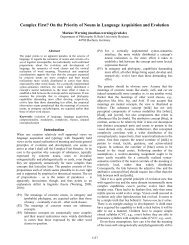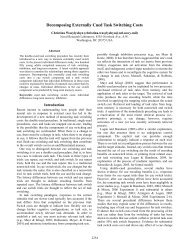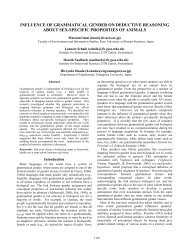Mental Simulation of Spatial Perspective during Sentence ...
Mental Simulation of Spatial Perspective during Sentence ...
Mental Simulation of Spatial Perspective during Sentence ...
Create successful ePaper yourself
Turn your PDF publications into a flip-book with our unique Google optimized e-Paper software.
were meaningful). 48 <strong>of</strong> the meaningless fillers had the<br />
same sentence structure as the target sentences. The<br />
meaninglessness was established by impossible actions.<br />
Hypotheses<br />
If comprehenders simulate the agent's/subject's/topic's<br />
perspective, and the 1 st person perspective does not<br />
influence the ACE at all, compatible responses should be<br />
faster than incompatible responses for all three sentence<br />
types. The same result is expected, if only verb direction is<br />
simulated. If the 1 st person perspective contributes to the<br />
ACE, we expect that in sentences with 1 st person subjects,<br />
latencies for compatible responses are smaller if verb and<br />
response directions are compatible, compared to the 3 rd /3 rd<br />
person sentences in which two 3 rd person protagonists<br />
interact with each other. When the 1 st person pronoun is in<br />
object position, its perspective differs from the subject's,<br />
topic's and agent's perspective. If all perspectives compete<br />
with each other, we expect elevated response latencies. If,<br />
however, the 1 st person pronouns lure participants to adopt a<br />
2 nd person perspective, the 3 rd /3 rd person sentences should<br />
still show the ACE. The other sentences should either show<br />
no effect, if participants do not simulate the perspective <strong>of</strong><br />
one <strong>of</strong> the protagonists, or there could be an effect for both<br />
sentence types, if the verb direction or the agent's/subject's/<br />
topic's perspective still directs the simulation regardless <strong>of</strong><br />
the 2 nd person pronoun.<br />
Participants<br />
Twenty-five students (10 female, 15 male) <strong>of</strong> the University<br />
<strong>of</strong> Freiburg voluntarily participated in the experiment. All<br />
participants were German native speakers, two grew up<br />
bilingually, one with English the other one with Italian as<br />
the second native language. The participant's age ranged<br />
between 23 and 36 years, the mean age was 26.5 years.<br />
Procedure<br />
Participants were instructed to read the sentences on a<br />
computer screen and to decide whether they were<br />
meaningful or not. They had to indicate their judgment by<br />
pressing one <strong>of</strong> two buttons as quickly as possible. We used<br />
a computer keyboard (see Figure 1) where all keys were<br />
removed except for three that were located in line, such that<br />
the middle button, the Z-key 1 , was equally far from the<br />
other two buttons. The outer buttons were replaced by a 3x3<br />
cm styr<strong>of</strong>oam top piece with the symbols '*' and 'o' to make<br />
them easier to press. The keyboard was turned by 90° so<br />
that the short side pointed towards the participant. Since the<br />
participant's index finger was placed on the Z-key <strong>during</strong><br />
the presentation <strong>of</strong> the sentences, they had to stretch their<br />
arms away from their bodies to reach the o-button and had<br />
to move the arm towards their body to reach the *-button.<br />
The keyboard was placed to the right <strong>of</strong> the participants for<br />
right-handed, and to the left for left-handed participants.<br />
1 Note that the Z-key is in the middle <strong>of</strong> the German keyboard<br />
on the position where the Y-key is on an English keyboard.<br />
After half <strong>of</strong> the trials, the direction <strong>of</strong> the correct<br />
response was inverted, so that compatible and incompatible<br />
responses had to be given in both directions. Also, half <strong>of</strong><br />
the participants started with the o-button and continued with<br />
the *-button for the meaningful-judgment, half <strong>of</strong> the<br />
participants vice versa. Furthermore, all target items were<br />
distributed to the lists in a way that each item was tested in<br />
both directions. Hence, any potential interaction <strong>of</strong> armmovement<br />
direction that cannot be attributed to<br />
compatibility was eliminated.<br />
Figure 1: Vertical three-button-keyboard<br />
Participants were instructed in detail about the procedure<br />
<strong>of</strong> the experiment. Each trial started with a fixation cross in<br />
the center <strong>of</strong> the screen. Participants had to press the Zbutton<br />
to start the sentence presentation and had to hold it<br />
down until the end <strong>of</strong> the trial. <strong>Sentence</strong>s were presented in<br />
a stationary window word-by-word, using a rapid serial<br />
visual presentation (RSVP) paradigm implemented in<br />
DMDX (Forster & Forster, 2003). Each word was presented<br />
for 200 ms plus 28 ms for each character. At the end <strong>of</strong> each<br />
sentence - marked by “***” - participants were instructed to<br />
respond as quickly as possible by indicating whether the<br />
presented sentence was meaningful or not. In order to do so,<br />
they had to release the middle button and press either the<br />
button located closer to their body or the button further<br />
away from their body.<br />
When participants released the Z-key before the end <strong>of</strong><br />
the sentence, presentation was stopped and participants were<br />
reminded to wait until the end <strong>of</strong> the sentence. No data were<br />
recorded for these trials. After accepting this notification by<br />
button press, they had to start the presentation <strong>of</strong> the next<br />
sentence by pressing the Z-key again. At the beginning <strong>of</strong><br />
both parts <strong>of</strong> the experiment five training items were<br />
presented. After each training item, but not after<br />
experimental items, a feedback message was presented on<br />
the screen indicating the response the participant gave.<br />
When participants released the Z-key before the end <strong>of</strong> the<br />
sentence <strong>during</strong> training, the training run was extended. The<br />
whole experiment ran about 30 minutes.<br />
Results<br />
One <strong>of</strong> the participants rated less than 50% <strong>of</strong> the target<br />
sentences as meaningful and was excluded from analysis.<br />
Data <strong>of</strong> 24 participants were analyzed. 15% <strong>of</strong> the original<br />
data points were eliminated, because <strong>of</strong> technical errors or<br />
because they had been rated as not meaningful. Extreme<br />
939


